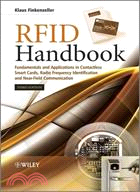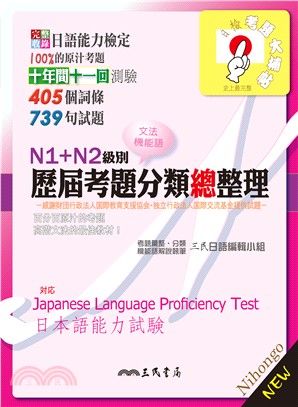Rfid Handbook - Fundamentals And Applications In Contactless Smart Cards,Radio Frequency Identification And Near-Field Communication, 3E
商品資訊
ISBN13:9780470695067
出版社:John Wiley & Sons Inc
作者:Finkenzeller
出版日:2010/06/18
裝訂/頁數:精裝/480頁
規格:25cm*17cm (高/寬)
定價
:NT$ 7066 元優惠價
:90 折 6359 元
若需訂購本書,請電洽客服 02-25006600[分機130、131]。
商品簡介
作者簡介
目次
相關商品
商品簡介
This is the third revised edition of the established and trusted RFID Handbook; the most comprehensive introduction to radio frequency identification (RFID) available.
This essential new edition contains information on electronic product code (EPC) and the EPC global network, and explains near-field communication (NFC) in depth. It includes revisions on chapters devoted to the physical principles of RFID systems and microprocessors, and supplies up-to-date details on relevant standards and regulations.
Taking into account critical modern concerns, this handbook provides the latest information on:
the use of RFID in ticketing and electronic passports;
the security of RFID systems, explaining attacks on RFID systems and other security matters, such as transponder emulation and cloning, defence using cryptographic methods, and electronic article surveillance;
frequency ranges and radio licensing regulations.
The text explores schematic circuits of simple transponders and readers, and includes new material on active and passive transponders, ISO/IEC 18000 family, ISO/IEC 15691 and 15692. It also describes the technical limits of RFID systems.
A unique resource offering a complete overview of the large and varied world of RFID, Klaus Finkenzeller’s volume is useful for end-users of the technology as well as practitioners in auto ID and IT designers of RFID products. Computer and electronics engineers in security system development, microchip designers, and materials handling specialists benefit from this book, as do automation, industrial and transport engineers. Clear and thorough explanations also make this an excellent introduction to the topic for graduate level students in electronics and industrial engineering design.
Klaus Finkenzeller was awarded the Fraunhofer-Smart Card Prize 2008 for the second edition of this publication, which was celebrated for being an outstanding contribution to the smart card field.
This essential new edition contains information on electronic product code (EPC) and the EPC global network, and explains near-field communication (NFC) in depth. It includes revisions on chapters devoted to the physical principles of RFID systems and microprocessors, and supplies up-to-date details on relevant standards and regulations.
Taking into account critical modern concerns, this handbook provides the latest information on:
the use of RFID in ticketing and electronic passports;
the security of RFID systems, explaining attacks on RFID systems and other security matters, such as transponder emulation and cloning, defence using cryptographic methods, and electronic article surveillance;
frequency ranges and radio licensing regulations.
The text explores schematic circuits of simple transponders and readers, and includes new material on active and passive transponders, ISO/IEC 18000 family, ISO/IEC 15691 and 15692. It also describes the technical limits of RFID systems.
A unique resource offering a complete overview of the large and varied world of RFID, Klaus Finkenzeller’s volume is useful for end-users of the technology as well as practitioners in auto ID and IT designers of RFID products. Computer and electronics engineers in security system development, microchip designers, and materials handling specialists benefit from this book, as do automation, industrial and transport engineers. Clear and thorough explanations also make this an excellent introduction to the topic for graduate level students in electronics and industrial engineering design.
Klaus Finkenzeller was awarded the Fraunhofer-Smart Card Prize 2008 for the second edition of this publication, which was celebrated for being an outstanding contribution to the smart card field.
作者簡介
Klaus Finkenzeller was awarded the Fraunhofer-Smart Card Prize 2008 for the second edition of this publication, which was celebrated for being an outstanding contribution to the smart card field.
目次
Preface to the Third Edition
List of Abbreviations
1 Introduction
1.1 Automatic Identification Systems
1.2 A Comparison of Different ID Systems
1.3 Components of an RFID System
2 Differentiation Features of RFID Systems
2.1 Fundamental Differentiation Features
2.2 Transponder Construction Formats
2.3 Frequency, Range and Coupling
2.4 Active and Passive Transponder
2.5 Information Processing in the Transponder
2.6 Selection Criteria for RFID Systems
3 Fundamental Operating Principles
3.1 1-Bit Transponder
3.2 Full- and Half-Duplex Procedure
3.3 Sequential Procedures
3.4 Near-Field Communication (NFC)
4 Physical Principles of RFID Systems
4.1 Magnetic Field
4.2 Electromagnetic Waves
4.3 Surface Waves
5 Frequency Ranges and Radio Licensing Regulations
5.1 Frequency Ranges Used
5.2 The International Telecommunication Union (ITU)
5.3 European Licensing Regulations
5.4 National Licensing Regulations in Europe
5.5 National Licensing Regulations
5.6 Comparison of National Regulations
6 Coding and Modulation
6.1 Coding in the Baseband
6.2 Digital Modulation Procedures
7 Data Integrity
7.1 The Checksum Procedure
7.2 Multi-Access Procedures – Anticollision
8 Security of RFID Systems
8.1 Attacks on RFID Systems
8.2 Protection by Cryptographic Measures
9 Standardisation
9.1 Animal Identification
9.2 Contactless Smart Cards
9.3 ISO/IEC 69873 – Data Carriers for Tools and Clamping Devices
9.4 ISO/IEC 10374 – Container Identification
9.5 VDI 4470 – Anti-theft Systems for Goods
9.6 Item Management
10 The Architecture of Electronic Data Carriers
10.1 Transponder with Memory Function
10.2 Microprocessors
10.3 Memory Technology
10.4 Measuring Physical Variables
11 Readers
11.1 Data Flow in an Application
11.2 Components of a Reader
11.3 Integrated Reader ICs
11.4 Connection of Antennas for Inductive Systems
11.5 Reader Designs
11.6 Near-Field Communication
12 The Manufacture of Transponders and Contactless Smart Cards
12.1 Glass and Plastic Transponders
12.2 Contactless Smart Cards
13 Example Applications
13.1 Contactless Smart Cards
13.2 Public Transport
13.3 Contactless Payment Systems
13.4 NFC Applications
13.5 Electronic Passport
13.6 Ski Tickets
13.7 Access Control
13.8 Transport Systems
13.9 Animal Identification
13.10 Electronic Immobilisation
13.11 Container Identification
13.12 Sporting Events
13.13 Industrial Automation
14 Appendix
14.1 Contact Addresses, Associations and Technical Periodicals
14.2 Relevant Standards and Regulations
14.3 Printed Circuit Board Layouts
References
Index
List of Abbreviations
1 Introduction
1.1 Automatic Identification Systems
1.2 A Comparison of Different ID Systems
1.3 Components of an RFID System
2 Differentiation Features of RFID Systems
2.1 Fundamental Differentiation Features
2.2 Transponder Construction Formats
2.3 Frequency, Range and Coupling
2.4 Active and Passive Transponder
2.5 Information Processing in the Transponder
2.6 Selection Criteria for RFID Systems
3 Fundamental Operating Principles
3.1 1-Bit Transponder
3.2 Full- and Half-Duplex Procedure
3.3 Sequential Procedures
3.4 Near-Field Communication (NFC)
4 Physical Principles of RFID Systems
4.1 Magnetic Field
4.2 Electromagnetic Waves
4.3 Surface Waves
5 Frequency Ranges and Radio Licensing Regulations
5.1 Frequency Ranges Used
5.2 The International Telecommunication Union (ITU)
5.3 European Licensing Regulations
5.4 National Licensing Regulations in Europe
5.5 National Licensing Regulations
5.6 Comparison of National Regulations
6 Coding and Modulation
6.1 Coding in the Baseband
6.2 Digital Modulation Procedures
7 Data Integrity
7.1 The Checksum Procedure
7.2 Multi-Access Procedures – Anticollision
8 Security of RFID Systems
8.1 Attacks on RFID Systems
8.2 Protection by Cryptographic Measures
9 Standardisation
9.1 Animal Identification
9.2 Contactless Smart Cards
9.3 ISO/IEC 69873 – Data Carriers for Tools and Clamping Devices
9.4 ISO/IEC 10374 – Container Identification
9.5 VDI 4470 – Anti-theft Systems for Goods
9.6 Item Management
10 The Architecture of Electronic Data Carriers
10.1 Transponder with Memory Function
10.2 Microprocessors
10.3 Memory Technology
10.4 Measuring Physical Variables
11 Readers
11.1 Data Flow in an Application
11.2 Components of a Reader
11.3 Integrated Reader ICs
11.4 Connection of Antennas for Inductive Systems
11.5 Reader Designs
11.6 Near-Field Communication
12 The Manufacture of Transponders and Contactless Smart Cards
12.1 Glass and Plastic Transponders
12.2 Contactless Smart Cards
13 Example Applications
13.1 Contactless Smart Cards
13.2 Public Transport
13.3 Contactless Payment Systems
13.4 NFC Applications
13.5 Electronic Passport
13.6 Ski Tickets
13.7 Access Control
13.8 Transport Systems
13.9 Animal Identification
13.10 Electronic Immobilisation
13.11 Container Identification
13.12 Sporting Events
13.13 Industrial Automation
14 Appendix
14.1 Contact Addresses, Associations and Technical Periodicals
14.2 Relevant Standards and Regulations
14.3 Printed Circuit Board Layouts
References
Index
主題書展
更多
主題書展
更多書展今日66折
您曾經瀏覽過的商品
購物須知
外文書商品之書封,為出版社提供之樣本。實際出貨商品,以出版社所提供之現有版本為主。部份書籍,因出版社供應狀況特殊,匯率將依實際狀況做調整。
無庫存之商品,在您完成訂單程序之後,將以空運的方式為你下單調貨。為了縮短等待的時間,建議您將外文書與其他商品分開下單,以獲得最快的取貨速度,平均調貨時間為1~2個月。
為了保護您的權益,「三民網路書店」提供會員七日商品鑑賞期(收到商品為起始日)。
若要辦理退貨,請在商品鑑賞期內寄回,且商品必須是全新狀態與完整包裝(商品、附件、發票、隨貨贈品等)否則恕不接受退貨。
























